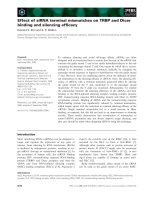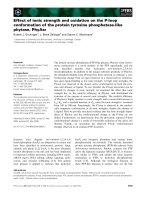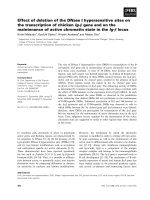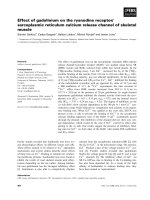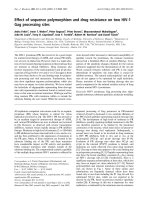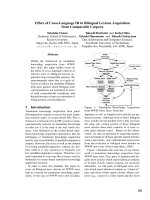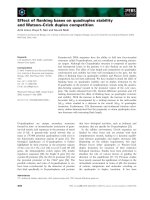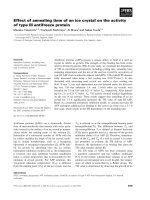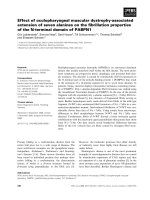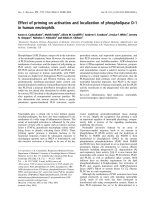Báo cáo khoa học: "Effect of β -mercaptoethanol or epidermal growth factor supplementation on in vitro maturation of canine oocytes collected from dogs with different stages of the estrus cycle" ppsx
Bạn đang xem bản rút gọn của tài liệu. Xem và tải ngay bản đầy đủ của tài liệu tại đây (3.44 MB, 6 trang )
-2851$/ 2)
9H W H U L Q D U \
6FLHQFH
J. Vet. Sci.
(2004),
/
5
(3), 253–258
Effect of
β
-mercaptoethanol or epidermal growth factor supplementation
on
in vitro
maturation of canine oocytes collected from dogs with different
stages of the estrus cycle
Min Kyu Kim
1
, Yuda Heru Fibrianto
1
, Hyun Ju Oh
1
, Goo Jang
1
, Hye Jin Kim
1
, Kyu Seung Lee
2
,
Sung Keun Kang
1,3
, Byeong Chun Lee
1,3,
*, Woo Suk Hwang
1,3,4
1
Department of Theriogenology and Biotechnology, College of Veterinary Medicine, Seoul National University, Seoul 151-742, Korea
2
Department of Animal Science, College of Agriculture and Life Sciences, Chungnam National University, Daejeon 305-764, Korea
3
The Xenotransplantation Research Center, Seoul National University Hospital, Seoul 110-744, Korea
4
School of Agricultural Biotechnology, Seoul National University, Seoul 151-742, Korea
Supplementation of
β
-mercaptoethanol (
β
-ME) in
in vitro
maturation (IVM) medium was shown to improve embryo
development and quality in several species. Epidermal
growth factor (EGF) was also shown to improve IVM of
human oocyte and embryo development after
in vitro
fertilization (IVF). The effect of these two compounds were
suggested to be mediated through the synthesis of
glutathione (GSH) which is known to play an important role
in protecting the cell or embryos from oxidative damage.
Thus, it is suggested that supplementation of canine IVM
medium with
β
-ME or EGF may be of benefit due to its
positive role in IVM of various mammalian oocytes and
embryo development, including cattle, pigs, rodents and
humans. This study investigates the effect of ovarian estrus
stage on canine oocyte quality and supplementation of
medium with
β
-ME or EGF on IVM of canine oocytes. As
results, a significantly higher percentage of oocytes
progressed to metaphase II (MII) stage in 50 or 100
µ
M of
β
-
ME supplemented oocytes collected from the follicular stage.
The maturation rate to metaphase I (MI) stage was also
significantly higher in oocytes collected from follicular stage
and cultured with 25 or 100
µ
M compared to other
experimental groups. After IVM culture, oocytes recovered
from dogs with the follicular stage and matured in TCM-199
supplemented with 20 ng/ml EGF yielded better oocyte
maturation to MII phase compared to other groups. Taken
together, supplementation of
β
-ME (50 or 100
µ
M) or EGF
(20 ng/ml) improved IVM of canine oocytes to MII stage.
Key words:
β
-mercaptoethanol (
β
-ME), epidermal growth
factor (EGF), canine oocytes,
in vitro
maturation (IVM).
Introduction
The efficiency of
in vitro
maturation (IVM) of canine
oocytes is still very low compared to that found in other
mammalian species. Small proportions of canine oocytes
completed nuclear maturation after being cultured for 48 to
72 h
in vitro
[20,27,30]. Low maturation rates could be due
to either suboptimal culture conditions or low meiotic
competence of the oocytes [7]. Studies are in progress to
determine both the culture requirements for canine oocytes
and some parameters indicative of maturation competence.
The morphological appearance of cumulus-oocyte complexes
(COCs) and oocyte diameter have been identified as
parameters indicative of maturation competence [14]. In
contrast to most mammals, bitches ovulate immature
oocytes that require 2-5 days for the completion of meiosis
within the oviduct [16] and remain surrounded by a tight and
multilayered cumulus cell mass [28]. The immature stage of
oocytes at ovulation and the persistence of cumulus cells
during transport and maturation within the oviduct,
indicating that investigation of the relationship between
cumulus cells and oocytes should help to clarify the reasons
for the low IVM rates of canine oocytes. This results also
suggests the importance of selecting good quality of COCs
by morphological appearance for IVM of oocytes.
Increased oxidative stress is one of the causes of impaired
IVM of oocyte. The GSH is the major nonprotein sulphynyl
compound in mammalian cells and is known to play an
important role in protecting the cell from oxidative damage.
The
β
-mercaptoethanol (
β
-ME) is low molecular weight
thiol and supplementation of
β
-ME in IVM medium has
shown to increase intracellular glutathione (GSH) content in
bovine oocytes and to improve embryo development and
quality in several species [24,25,29]. Moreover, the presence
of thiol compound in a maturation medium increased the
GSH level and improved developmental competence of pig
*Corresponding author
Tel: +82-2-880-1269; Fax: +82-2-884-1902
E-mail:
254 Min Kyu Kim
et al.
oocytes [1]. GSH is also known to be important for sperm
chromatin decondensation and male pronucleus formation
after sperm penetration, supporting its possible role in
encouraging oocyte cytoplasmic maturation [8]. A mechanism
by which
β
-ME promotes intracellular GSH synthesis was
proposed by Takahasi
et al
. [32]. In lymphocytes,
β
-ME
promotes the uptake of cysteine, enhancing GSH synthesis
[18]. It has been suggested that GSH protects cells from
oxidative damage [9,26,34]. Thus, increased intracellular
GSH induced by
β
-ME may provide embryos with a better
intracellular condition, preventing oxidative damaged
possibly promoting late embryonic development.
Several hypotheses suggest that epidermal growth factor
(EGF) acts on cells as both a paracrine and autocrine
regulator of ovarian function [3,12]. The EGF is one of
many growth factors found throughout the body, including
growing antral follicles within the ovary, and has shown to
stimulate DNA synthesis and cell proliferation in porcine
granulosa cells. The EGF also improves IVM of human
oocyte and embryo development after
in vitro
fertilization
(IVF) [11]. Supplementation of canine IVM medium with
EGF may be of benefit due to its positive role in various
other mammalian IVM and embryo culture systems
including cattle, pigs, rodents and humans [6,15,22]. In the
serum of both pigs and humans, EGF levels have been
reported at 8 ng/ml and 1.2-3.75 ng/ml, respectively, while
in the follicular fluid, EGF level were varied from 2 to 15
ng/ml in both species [22]. The EGF was reported to cause
an increase in the number of mouse oocytes undergoing
germinal vesicle breakdown (GVBD), and to cause cumulus
expansion in bovine and mouse COCs.
Consequently, this study investigates the effect of ovarian
estrus stage on oocyte quality and supplementation of
medium with
β
-ME or EGF on IVM of canine oocytes.
Materials and Methods
Oocyte collection
Reproductive tracts from normal bitches greater than 6
months of age were collected after routine ovariohysterectomy
at private clinics, placed immediately into physiological
saline solution (PSS) at 37
o
C and transported back to the
laboratory within 1 h. Ovaries were removed from the tract
and washed free from blood in fresh PSS, and then
repeatedly slashed with a #10 scalpel blade or shaving blade
(Dorco, Seoul, Korea) at room temperature in bench
medium consisting of M-199 with 25 mM HEPES (Sigma,
St Louis, MO) supplemented with 1% fetal calf serum
(FBS, Life technology, Rockville, MD) and 1% penicillin-
streptomycin (P/S) comprised of 10,000 U/ml of penicillin
G sodium and 10,000
µ
g/ml streptomycin sulfate (Sigma).
Only grade I & II oocytes >100
µ
m in diameter were
selected and used for the experiments. Oocytes were washed
3 times in the bench medium to wash off blood and other
debris prior to transfer to maturation medium.
Removal of cumulus cell and assessment of meiotic
stage
At the end of the maturation culture, oocytes were
completely denuded via gently pipetting with a fine bore
glass pipette and a solution of 0.2% (w/v) hyaluronidase
(Sigma) in the bench medium. The oocytes were then fixed
in a 3.7% formaldehyde-Triton X-100 (Sigma) solution for
10 min, washed in PBS for an additional 3 min, mounted on
a slide and stained with 1.9
µ
M Hoechst 33342 (Sigma) in
glycerol (Sigma). Oocytes were then evaluated under UV
light to determine the stage of meiosis as defined in Table 1
and Fig. 1.
Experimental design
Supplementation of
β
-ME in TCM-199 (Experiment 1).
In this experiment, whether
β
-ME promotes completion
of nuclear maturation in canine oocytes was evaluated. The
concentrations of
β
-ME tested were 0.0 (control), 25, 50 and
100
µ
M. After 72 h of
in vitro
culture, oocytes were
evaluated for nuclear meiotic stage as previously defined in
Table 1 and Fig. 1.
EGF supplementation in TCM-199 (Experiment 2).
In this experiment, the effect of supplementation of EGF
to basic maturation medium on IVM of canine oocytes was
evaluated as previously defined in Table 1 and Fig. 1. The
concentrations of EGF tested were 0.0 (control), 10 and 20
ng/ml.
Statistical analysis
Multiple comparisons (LSD) were implemented using
Generalized Linear Models in the SAS 8.12 program. When
the significant effect in each experimental parameter was
detected, subsequent comparison was made by the least
Table 1. Definition of meiotic classification in canine oocytes stained after
in vitro
maturation
Classification Description
Germinal vesicle (GV) Germinal vesicle (nuclear envelope) still intact; scattered chromatin
Germinal vesicle break down (GVBD)Organization and condensation of chromatin into chromosomes
Metaphase I (MI) Alignment of chromosomes on meiotic spindle
Metaphase II (MII) Meiotic division resulting in chromosome number reduction and expulsion of first polar body
Degenerate/dead Abnormal chromosomal configuration/no visible chromatin material
Effect of
β
-mercaptoethanol or epidermal growth factor supplementation on canine oocytes 255
square method. Difference among the treatment were
considered statistically significant when the
p
-values were
less than 0.05.
Result
Supplementation of
β
-ME in TCM-199
The result of Experiment 1 showed that a significantly
higher percentage of oocytes progressed to metaphase II
(MII) (20 or 13%, respectively) in 50 or 100
µ
M
β
-ME
supplemented oocytes collected from the follicular stage
(Table 2). The maturation rate to metaphase I (MI) stage was
also significantly higher in oocytes collected from follicular
stage and treated with 25 or 100
µ
M (29 or 32%,
respectively) compared to that observed in other experimental
groups (
p
< 0.05).
EGF supplementation in TCM-199
In Experimental 2, after 72 h culture, oocytes recovered
from the follicular stage and matured in TCM-199
supplemented with EGF 20 ng/ml yielded better oocyte
maturation to MII phase compared to other groups (13 % vs.
3 to 6 %, respectively) (Table 3).
Discussion
Unlike other mammalian oocytes, ovulated canine oocytes
complete meiotic maturation within 2-5 days in the oviduct
after ovulation [4,16]. At present, IVM of canine oocytes is
characterized by low and greatly variable success rates [7].
Studies have been performed to improve the rate of IVM in
canine oocytes by supplementing the culture medium with
various serum [25,29], gonadotrophin [15] or steroid
hormone [15]. The present study investigated the effect of
β
-
ME or EGF supplementation on the base of the stages of the
estrus cycle of the ovaries, and demonstrated that
β
-ME or
EGF supplementation significantly increased maturation of
canine oocyte to MII stage.
A number of studies have demonstrated an effect of stage
of the estrous cycle on the meiotic competence of canine
oocytes matured
in vitro
. Yamada
et al
. [35] reported that
32% of preovulatory oocytes collected from superovulated
bitches reached MII after 72 h of culture, whereas oocytes
from anestrus bitches showed no tendency to resume
meiosis even after a culture period of up to 144 h. In a
similar investigation by Luvoni
et al
. [23], a high percentage
of the oocytes collected during anestrus were in the germinal
F
ig. 1. Canine oocytes stained with Hoechst 33342 and visualized under UV light. Germinal vesicle (A), germinal vesicle breakdow
n
(
B), metaphase I (C) and metaphase II (D) (x200).
256 Min Kyu Kim
et al.
vesicle breakdown (GVBD) stage at the time of collection.
Such oocytes could be derived from atretic follicles, which
are usually ruptured by the slicing procedure used for
collection. It is generally accepted that GVBD can occur
spontaneously in human atretic follicles [11]. In contrast,
Hewitt and England [15] reported that no significant
differences in maturation rates were observed between
oocytes collected at proestrus and estrus stages. In the
present study, higher proportion of oocytes collected from
the follicular stage ovaries reached MI and MII stage in the
absence or presence of
β
-ME or EGF compared to those
collected from ovaries of anestrus and luteal stages. Our
results indicate the importance of oocytes recovery phase to
select potentially meiotically competent canine oocytes for
use of
in vitro
experiment.
Glutathione (GSH) is the major non-protein sulfydryl
compound present in mammalian cells. Multiple actions
have been described for GSH, including increasing amino
acid transport, stimulating DNA and protein synthesis,
reduction of disulfides and protection against toxic effects of
oxidative damage [21]. Takahashi
et al
. [33] demonstrated
that the supplementation of low molecular weight thiol
compound, to culture medium can increase the cystein-
mediated GSH synthesis in bovine embryo produced
in
vitro
. Similarly, addition of
β
-ME increased intracellular
GSH in mouse lymphocytes [37]. It has been shown that this
thiol-compound stimulates glutathione synthesis [24],
which, in turn, protects the bovine oocytes from oxidative
damage. Addition of
β
-ME to chemical defined maturation
medium also increased the percentage of ovine oocytes
completing nuclear maturation [25]. The result of the
present study demonstrated that supplementation of canine
IVM medium with
β
-ME at 50 or 100
µ
M had beneficial
effects on meiotic competence of oocytes collected from the
Table 2.
Meiotic status of canine oocytes recovered from different ovarian estrus stages and cultured in TCM-199 supplemented with
various concentrations of β-mercaptoethanol (β-ME)
Estrus stages β-ME (µM)
No. of oocytes
examined
% nuclear status of oocytes (mean ± SD)
GV GVBD MI MII
Anestrus
0 51 31.3 ± 6.3
a
39.2 ± 6.8 00.0 ± 4.7
a
00.0 ± 2.4
a
25 27 37.0 ± 8.6
ab
37.0 ± 9.3 14.8 ± 6.5
ab
00.0 ± 3.3
a
50 65 29.2 ± 5.5
a
40.0 ± 6.0 13.8 ± 4.2
b
03.0 ± 2.1
a
100 46 30.4 ± 6.6
a
52.1 ± 7.1 6.5 ± 5.0
a
00.0 ± 2.5
a
Follicular
0 36 22.2 ± 7.5
a
44.4 ± 8.1 16.6 ± 5.6
bc
00.0 ± 2.8
a
25 21 19.0 ± 9.8
a
52.3 ± 10.6 28.5 ± 7.4
c
00.0 ± 3.7
a
50 30 13.3 ± 8.2
a
46.6 ± 8.9 16.6 ± 6.1
bc
20.0 ± 3.1
b
100 31 25.8 ± 8.0
a
25.8 ± 8.7 32.2 ± 6.0
c
12.9 ± 3.1
b
Luteal
0 84 36.9 ± 4.9
ab
36.9 ± 5.3 13.0 ± 3.7
b
02.3 ± 1.8
a
25 69 18.8 ± 5.4
a
37.6 ± 5.8 17.3 ± 4.0
bc
02.8 ± 2.0
a
50 84 47.6 ± 4.9
b
29.7 ± 5.3 11.9 ± 3.7
b
03.5 ± 1.8
a
100 65 21.5 ± 5.5
a
43.0 ± 6.0 10.7 ± 4.2
a
01.5 ± 2.1
a
a-c
Values with different superscripts are significantly different (
p
<0.05)
Table 3.
Meiotic status of canine oocytes recovered from different ovarian estrus stages and cultured in TCM-199 supplemented with
various concentrations of epidermal growth factor (EGF)
Estrus stages EGF (ng/ml)
No. of oocytes
examined
% nuclear status of oocytes (mean ± SD)
GV GVBD MI MII
Anestrus
0 80 27.5 ± 4.7
a
47.5 ± 5.5 08.7 ± 3.8
a
00.0 ± 1.9
a
10 126 28.5 ± 3.7
a
46.8 ± 4.4 07.9 ± 3.0
a
00.0 ± 1.5
a
20 122 31.9 ± 3.8
a
39.3 ± 4.4 15.5 ± 3.1
ab
01.6 ± 1.5
a
Follicular
0 36 16.6 ± 7.0
ab
44.4 ± 8.2 11.1 ± 5.7
ab
02.7 ± 2.8
ac
10 34 08.8 ± 7.2
b
29.4 ± 8.5 23.5 ± 5.8
b
05.8 ± 2.9
abc
20 45 08.8 ± 6.2
b
33.3 ± 7.3 20.0 ± 5.1
b
13.3 ± 2.5
b
Luteal
0 24 12.5 ± 8.5
ab
54.1 ± 10.1 12.5 ± 7.0
ab
04.1 ± 3.5
ac
10 31 25.8 ± 7.5
ab
51.6 ± 8.9 12.9 ± 6.1
ab
03.2 ± 3.1
ac
20 36 16.6 ± 7.0
ab
47.2 ± 8.2 27.7 ± 5.7
b
08.3 ± 2.8
bc
a-c
Values with different superscripts are significantly different (
p
<0.05)
Effect of
β
-mercaptoethanol or epidermal growth factor supplementation on canine oocytes 257
follicular stage, consistent with the result from Takahashi
et
al
. [32] in bovine IVM. As described above, it is important
to mention that the outcome of our experiments was most
likely influenced by the stage of the estrus cycle of the dogs
from which the oocytes were collected; the positive effect of
β
-ME on IVM of canine oocytes was only observed in the
oocytes collected from the follicular stage.
It is well established that the addition of EGF promote
in
vitro
oocyte maturation, and also improve fertilization and
cleavage rates in many species, including the pig, rat, mice
[5], fox [31], cow [19], and humans [17]. In addition to
accelerating nuclear maturation in the oocyte, literature also
suggests that the addition of EGF improves cytoplasmic
maturation [20]. Furthermore, studies indicate that EGF
induces oscillations in calcium efflux in COCs of mice, and
also promotes the synthesis of GSH within the oocyte [8].
The role of calcium oscillations in immature oocytes is not
as widely studied as it is in fertilization events, but it is
suggested to have a role in resumption of meiosis, as
described in research on amphibian and invertebrate oocytes
[15]. The results of the experiments presented in this study
demonstrated the benefit of supplementing canine IVM
medium with EGF. Supplementation of 20 ng/ml EGF in
TCM-199 showed significantly improved rate of meiotic
competence of oocytes collected from follicular stage. In
support of our results, a study reports a significant increase
in the blastocyst development from oocytes that were
cultured in serum-free medium supplemented with 10 ng/ml
EGF, and this was attributed to an increase in GSH synthesis
influenced by EGF [2]. It is also important to mention that
the outcome of our experiments was most likely influenced
by the stage of the estrus cycle of the dogs; the positive
effect of EGF supplementation on IVM of canine oocytes
was only observed in the oocytes collected from the
follicular stage.
In conclusion, supplementation of canine IVM medium
with GSH-synthesis stimulator,
β
-ME or EGF improved
IVM of canine oocytes collected from dogs with the
follicular stage of the estrus cycle.
References
1. Abeyderra LR, Wang WH, Cantley TC, Prather RS, Day
BN. Presence of
β
-mercaptoethanol can increase the
glutathione content of pig oocytes matured
in vitro
and the
rate of blastocyst development after
in vitro
fertilization.
Theriogenology 1998, 50, 747-756.
2. Abeyderra LR, Wang WH, Cantley TC, Rieke A,
Murphy CH, Prather RS, Day BN. Development and
viability of pig oocytes matured in a protein-free medium
containing epidermal growth factor. Theriogenology 2000,
54, 787-797.
3. Carson RS, Zhang Z, Hutchinson LA, Herington AC,
Findlay JK. Growth factors in ovarian function. J Reprod
Fertil 1989, 85, 735-746.
4. Concannon PW, McCann JP, Temple M. Biology and
endocrinology of ovulation, pregnancy and parturition in the
dog. J Reprod Fertil Suppl 1989, 39, 3-25.
5. Coskun S, Lin YC. Mechanism of action of epidermal
growth factor-induced porcine oocyte maturation. Mol
Reprod Dev 1995, 42, 311-317.
6. Downs SM. Specificity of epidermal growth factor action on
maturation of the murine oocyte and cumulus oophorus
in
vitro
. Biol Reprod 1989, 41, 371-379.
7. Farstad W. Current state in biotechnology in canine and
feline reproduction. Anim Reprod Sci 2000, 60-61, 375-387.
8. Furnus CC, DeMatos DG, Moses DF. Cumulus expansion
during
in vitro
maturation of bovine oocytes: relationship
with intracellular glutathione level and its role on subsequent
embryo development. Mol Reprod Dev 1998, 51, 76-83.
9. Gardiner CS, Reed DJ. Status of glutathione during
oxidant-induced oxidative stress in the preimplantation
mouse embryo. Biol Reprod 1994, 51, 1307-1314.
10. Gougeon A, Testart J. Germinal vesicle breakdown in
oocytes of human atretic follicles during the menstrual cycle.
J Reprod Fertil 1986, 78, 389-401.
11. Goud PT, Goud AP, Qian C, Laverge H, Van der Elst J,
De Sutter P, Dhont M.
In-vitro
maturation of human
germinal vesicle stage oocytes: role of cumulus cells and
epidermal growth factor in the culture medium. Human
Reprod 1998, 13, 1638-1644.
12. Hammond JM, Hsu CJ, Mondschein JS, Canning SF.
Paracrine and autocrine functions of growth factors in the
ovarian follicle. J Anim Sci 1988, 66, 21-31.
13. Harper KM, Brackett BG. Bovine blastocyst development
after
in vitro
maturation in a defined medium with epidermal
growth factor and low concentrations of gonadotropins. Biol
Reprod 1993, 48, 409-416.
14. Hewitt DA, England GCW. The effect of oocyte size and
bitch age upon oocyte nuclear maturation
in vitro
.
Theriogenology 1998, 49, 957-996.
15. Hewitt DA, England GCW. Effect of preovulatory
endocrine events on maturatin of oocytes of domestic bitches.
J Reprod Fertil Suppl 1997, 51, 8391.
16. Hill JL, Hammar K, Smith PJS, Gross DJ. Stage-
dependent effects of epidermal growth factor on Ca
2+
Efflux
in mouse oocytes. Mol Reprod Dev 1999, 53, 244-253.
17. Holst PA, Phemister RD. The Prenatal development of the
dog: preimplantation events. Biol Reprod 1971, 5, 194-206.
18. Hull KL, Harvey S. Growth hormone: a reproductive
endocrine-paracrine regulator. Rev Reprod 2000, 5, 175-182.
19. Ishii T, Hishinuma I, Bannai S, Sugita Y. Mechanism of
growth promotion of mouse lymphoma L1210 cells
in vitro
by feeder layer or 2-mercaptoethanol. J Cell Physiol 1981,
107, 283-293.
20. Izadyar F, Hage WJ, Colenbrander B, Bevers MM. The
promotory effect of growth hormone on the developmental
competence of
in vitro
matured bovine oocytes is due to
improved cytoplasmic maturation. Mol Reprod Dev 1998,
49, 444-453.
21. Kim MK, Kim HJ, Cho JK, Jang G, Lee KS, Kang SK,
Lee BC, Hwang WS.
In vitro
nuclear maturation of canine
oocytes obtained from differents stage of estrus cycle. Korean
258 Min Kyu Kim
et al.
J Embryo Transf 2002,
17
, 145-151
22.
Lim JM, Liou SS, Hansel W.
Intracytoplasmic glutathione
concentration and the role of
β
-mercaptoethanol in
preimplantation development of bovine embryos. Theriogenology
1996,
46
, 429-439.
23.
Lonergan P, Carolan C, Van Langendonckt A, Donnay I,
Khatir H, Mermillod P.
Role of epidermal growth factor in
bovine oocyte maturation and preimplantation embryo
development
in vitro
. Biol Reprod 1996,
54
, 1420-1429.
24.
Luvoni GC, Luciano AM, Modina S, Gandolfi F.
Influence
of different stages of the oestrous cycle on cumulus-oocyte
communications in canine oocytes: effects on the efficiency
of
in vitro
maturation. J Reprod Fertil Suppl 2001,
57
, 141-
146.
25.
Mahi CA, Yanagimachi R.
Maturation and sperm penetration
of canine ovarian oocytes
in vitro
. J Exp Zool 1976,
196
, 189-
196.
26.
Matos DG, Furnus CC.
The importance of having high
glutathione (GSH) level after bovine
in vitro
maturation on
embryo development: Effect of
β
-mercaptoethanol, cysteine
and cystine. Theriogenology 2000,
53
, 761-771.
27.
Matos DG, Gasparrini B, pasqualini SR, Thompson JG.
Effect of glutathione synthesis stimulation during
in vitro
maturation of ovine oocytes on embryo development and
intracellular peroxide content. Theriogenology 2002,
57
,
1443-1445.
28.
Meister A.
Selective modification of glutathione metabolism.
Science 1983,
29
, 472-477.
29.
Nickson DA, Boyd JS, Eckersall PD, Ferguson JM,
Harvey MJA, Renton JP.
Molecular biological methods for
monitoring oocyte maturation and
in vitro
fertilization in
bitches. J Reprod Fertil Suppl 1993,
47
, 231-240.
30.
Renton JP, Boyd JS, Eckersall PD, Ferguson JM, Harvey
MJ, Mullaney J, Perry B.
Ovulation, fertilization and early
embryonic development in the bitch (Canis familiaris). J
Reprod Fertil 1991,
93
, 221-231.
31.
Songsangen N, Apimeteetumrong M.
Effect of
β
-
mercaptoethanol on formation of pronuclei and developmental
competence of swamp buffalo oocytes. Anim Reprod Sci
2002,
72
, 193-202.
32.
Songsasen N, Yu I, Leibo SP.
Nuclear maturation of canine
oocytes cultured in protein-free media. Mol Reprod Dev
2002,
62
, 407-415.
33.
Srsen V, Kalous J, Nagyova E, Sutovsky P, King WA,
Motlik J.
Effects of follicle-stimulating hormone, bovine
somototrophin and okadaic acid on cumulus expansion and
nuclear maturation of Blue fox (Alopex lagopus) oocytes
in
vitro
. Zygote 1998,
6
, 299-309.
34.
Takahashi M, Nagai T, Hamano S, Kuwayama M,
Okamura N, Okano A.
Effect of thiol compounds on
in
vitro
development and intracellular glutathione content of
bovine embryos. Biol Reprod 1993,
49
, 228-232.
35.
Takahashi Y, Kanagawa H.
Effect of oxygen concentration
in the gas atmosphere during
in vitro
insemination of bovine
oocytes on the subsequent embryonic development
in vitro
. J
Vet Med Sci 1998,
60
, 365-367.
36.
Takahashi M, Nagai T, Okamura N, Takahashi H, Okano
A.
Promoting effect of
β
-mercaptoethanol on
in vitro
development under oxidative stress and cystine uptake of
bovine embryos. Biol Reprod 2002,
6
, 562-567.
37.
Yamada S, Shimazu Y, Kawaji M, Nakazawa M, Naito K,
Toyoda Y.
Maturation, fertilization and development of dog
oocytes
in vitro
. Biol Reprod 1992,
46
, 853-858.
38.
Yamada S, Shimazu Y, Kawano Y, Nakazawa M, Naito K,
Toyoda Y.
In vitro
maturation and fertilization of
preovulatory dog oocytes. J Reprod Fertil Suppl 1993,
47
,
227-229.
39.
Zmuda J, Friedenson B.
Changes in intracellular glutathione
levels in stimulated and unstimulated lymphocytes in the
presence of 2-mercaptoethanol or cysteine. J Immunol. 1983,
130
, 362-364.
